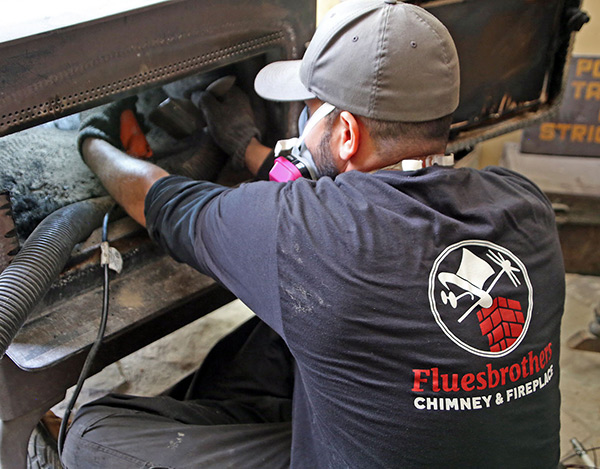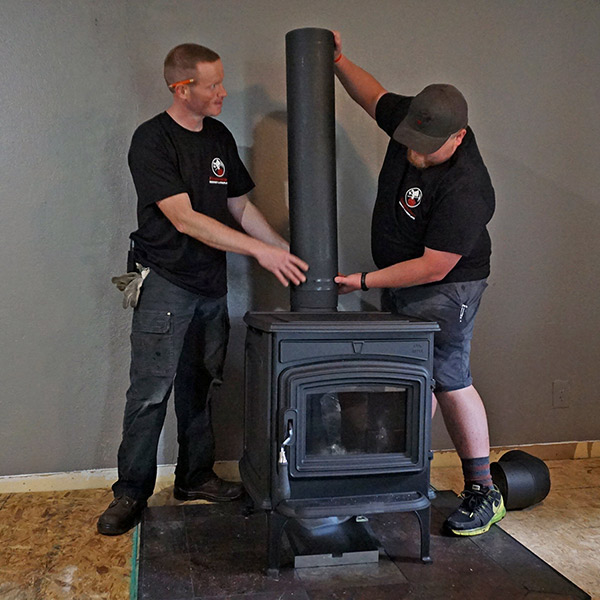Should I Replace or Repair My Wood Stove
A wood-burning stove is among the most efficient and affordable way to heat a home. When properly cleaned and maintained, a quality woodstove will provide years of reliable performance. But as it ages, you will eventually need to decide whether it’s better to repair or replace your wood-burning stove. The following guide will help to make that decision easier.
Excessive creosote accumulation
 The combustion of wood produces several natural by-products, including soot, ash, and creosote, to name a few. Creosote starts as a powdery substance but will turn into a thick, crusty, and highly flammable material that is extremely difficult to remove if allowed to accumulate. And if the wood stove is not regularly cleaned, the inside of your wood stove may look as if it is covered in burnt charcoal. When the amount of creosote is so excessive that it cannot be removed entirely, replacing the wood stove is the safest choice.
The combustion of wood produces several natural by-products, including soot, ash, and creosote, to name a few. Creosote starts as a powdery substance but will turn into a thick, crusty, and highly flammable material that is extremely difficult to remove if allowed to accumulate. And if the wood stove is not regularly cleaned, the inside of your wood stove may look as if it is covered in burnt charcoal. When the amount of creosote is so excessive that it cannot be removed entirely, replacing the wood stove is the safest choice.
Rusting or corrosion
Quality wood stoves are constructed with solid iron or heavy gauge steel frame. As durable as these materials are, the gases of a wood-burning fire can be corrosive. Moisture created during condensation or water leaks can cause rusting, primarily where the frame is welded together. Also, there are low-quality imports that may look like iron, but in reality, use low-gauge steel, which is more prone to rust and corrosion. Since rust and corrosion weaken the integrity of the wood stove, it is best to replace it.
Warping or cracking
As you can imagine, the heat inside a wood-burning stove can be intense. And although its construction is designed to withstand high temperatures, all materials have its limits. After many years of reliable performance, you may notice warping or cracks inside the firebox or around the frame. Like rust or corrosion, this is a sign of weakening and is another indication that it’s time to replace your wood stove.
 Smokey fires
Smokey fires
When you start to notice excessive smoke in the firebox, it is a sign of a potentially severe issue. The smoke and fumes are vented through the smoke pipe to an external vent or chimney. But when there is an obstruction, such as excessive creosote in the stovepipe or a blocked chimney or vent, smoke will back up into the wood stove. It can also result in exposure to dangerous carbon monoxide fumes. Burning unseasoned wood or woods with high moisture content will also cause excessive smoke and creosote.
You should have a qualified chimney sweep inspect your wood stove to determine the cause and make any necessary repairs.
Door seal failure
There is a rubber gasket attached to the stove door, so it will form an airtight seal when shut. When the gasket is warped, cracked, or otherwise damaged, it needs to be immediately replaced to prevent exposure to carbon monoxide and loss of heat. If the stove door gasket is no longer available for your model, the wood stove will need to be replaced.
Low heating efficiency
When the heating efficiency of a wood stove degrades, it will require more wood fuel to heat your home, thus increasing energy costs. You will also need to clean your wood stove more often. If your wood stove is not performing as efficiently as it should, its time to replace it with a more energy-efficient unit.
The post Should I Replace or Repair My Wood Stove appeared first on Fluesbrothers Chimney Service.
 Spa-like design has been trending for a while, making master bathrooms more beautiful than ever. A fireplace in the bathroom can provide an extra “wow factor” that makes your home feel like a veritable resort. Also, if you add a fireplace in your master bathroom, it would make you a design trendsetter! Even though a bathroom fireplace is a desirable feature among the majority of homebuyers surveyed, recent research revealed that only about 10% of all master bathrooms include a fireplace. This is an idea whose time has come.
Spa-like design has been trending for a while, making master bathrooms more beautiful than ever. A fireplace in the bathroom can provide an extra “wow factor” that makes your home feel like a veritable resort. Also, if you add a fireplace in your master bathroom, it would make you a design trendsetter! Even though a bathroom fireplace is a desirable feature among the majority of homebuyers surveyed, recent research revealed that only about 10% of all master bathrooms include a fireplace. This is an idea whose time has come. Zone heating, as referred to above, makes the best sense when everyone’s bedroom is equipped with a fireplace. Bedrooms can be enjoyed more than ever as individualized personal sanctuaries when there’s a fireplace to keep you warm and provide an ambiance that feeds the soul. There’s something about a mesmerizing fire that makes it an old-world luxury anywhere, anytime.
Zone heating, as referred to above, makes the best sense when everyone’s bedroom is equipped with a fireplace. Bedrooms can be enjoyed more than ever as individualized personal sanctuaries when there’s a fireplace to keep you warm and provide an ambiance that feeds the soul. There’s something about a mesmerizing fire that makes it an old-world luxury anywhere, anytime.
 The majority of homeowners who look into purchasing a fireplace blower are those using open masonry fireplaces. This style of fireplace is beautiful to look at and brings lots of ambiance to a room, but it’s not known as a producer of high heat. There’s plenty of heat in the firebox, but usually 80% or more of it channels right up the chimney and is lost forever.
The majority of homeowners who look into purchasing a fireplace blower are those using open masonry fireplaces. This style of fireplace is beautiful to look at and brings lots of ambiance to a room, but it’s not known as a producer of high heat. There’s plenty of heat in the firebox, but usually 80% or more of it channels right up the chimney and is lost forever. Fireplace insert: These are heavy-duty appliances that come from a factory ready to install in the firebox of your masonry fireplace. Inserts produce and retain upwards of 80% of the heat they create, meaning a lot more heat for your home.
Fireplace insert: These are heavy-duty appliances that come from a factory ready to install in the firebox of your masonry fireplace. Inserts produce and retain upwards of 80% of the heat they create, meaning a lot more heat for your home.

 AIR / OXYGEN
AIR / OXYGEN HEAT
HEAT What Makes Smoke Go Up the Chimney?
What Makes Smoke Go Up the Chimney? Chimney Obstructions
Chimney Obstructions With countless old and historic homes throughout Boston, many homeowners have visions of getting cozy around the fireplace in the winter. However, the reality might be a lot different if your fireplace is unused for many years.
With countless old and historic homes throughout Boston, many homeowners have visions of getting cozy around the fireplace in the winter. However, the reality might be a lot different if your fireplace is unused for many years.